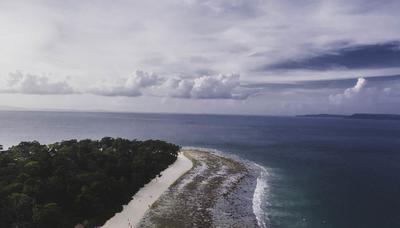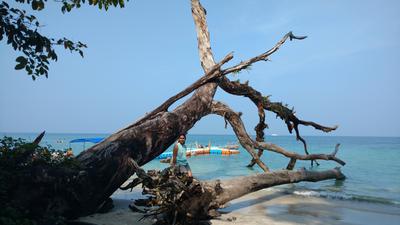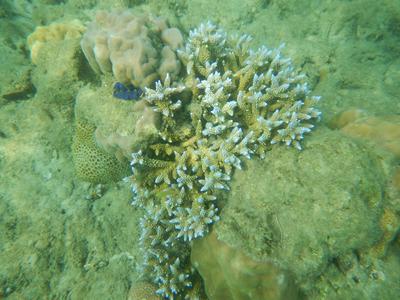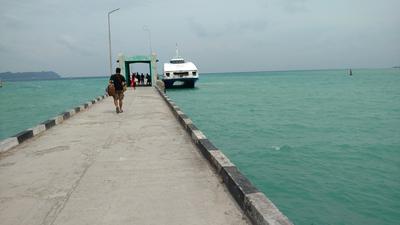
Custom Search
Amazing Andamans: Diving into Unknown Waters
by Annesha Pramanik
(Jamshedpur, Jharkhand)

Laxmanpur Beach
While I was studying geography in school, Andaman and Nicobar islands seemed like a painfully long name to remember for some far flung dots on the Indian map. The Indian sub-continent had more interesting places under Mughal kings and Deccan dynasties who had firmly established their kingdoms in my memory. Possibly, because of this, I wasn't prepared for the size of the Andaman and Nicobar islands –both physically and experientially.
Riding through the hilly roads of Port Blair with lush green ferns and coconut trees on the sides and glimpses of the British style wooden cottages, it's easy to imagine that nothing much has changed here since the 1700s when British colonialism first invaded the island. Before that, it was home to around 7000 people from 10 indigenous tribes out of which around 500 remain today belonging to 4 different tribes.
Even if you momentarily forget the remoteness of the islands-thanks to the passive insulation of air travel-the sights and facts encountered will continuously remind you about Andaman's historical branding of "isolated". The cellular jail with rows of solitary cells meant to isolate the most dangerous freedom fighters of India. Or the fact that almost everyone on the Andaman Islands is a descendant of refugees from Bangladesh sent here during the partition of India in 1947. Not surprisingly, one of the most isolated tribes of the world, the Sentilenese peoples are found on one of the islands.
This isolation is probably what saves it from being trampled by tourists. The vast expanse of clear, blue-green water of the Andaman Sea with its treasure of corals and colourful fishes against the pure white sand of coral dust gives each scene a surreal effect like colour enhanced reality.
I had gone to see the sunset at Laxmanpur beach on Neil Island. Walking along the two sides of the triangular beach, I sat at the tip of the triangle where the sea extended to infinity wherever I turned my eyes. That's when the island truly isolates, using the solitary confinement of nature. Away from the comforts of the city and the power trip of technology, what would I discover about myself if you I was left alone to survive on this island? Would I become like one of the indigenous tribes?
A standard itinerary of a tourist to the Andaman and Nicobar islands would have one day dedicated to visiting Baratang with the main attraction being Jarwa sighting. Jarwas are the semi-civilized, hunter-gatherer tribes of Andaman who live in a protected forest reserve area through which runs the Andaman Grand Trunk road. The courts of India prohibit tour operators from taking tourists for seeing Jarwas. The international world condemns Human Safaris of this kind. But hundreds of tourists make daily trips in convoys of 40-50 cars at particular times in a day. The paperwork shows transit through the reserve for visiting limestone caves reached by crossing a strait at the end of the road.
The driver of our car gave strict instructions of no photography and no halts during the 1.5-hour car ride through the Jarwa reserve. His licence could be suspended if he is found violating the Protection of Aboriginal Tribes Act, 1956. In spite of the ethical implications, I can't help feeling curious about seeing members of the tribe and catching a rare glimpse of their lives.
The flora of the forest is quite unlike mainland India possibly because the islands are believed to have separated from Indonesia. I was busy tracking a red flower that grew on a stem close to the ground as the images of the forest rushed past the car window when quite unexpectedly, my eyes caught a young man from the tribe sitting at a turn. He had an unblinking, piercing stare, eyes shining with the fierceness of complete independence. Later, our car rushed past 4 older adults dressed in headbands, necklaces, sitting atop a slope. One of them extended what looked like a long bamboo pole towards our car and looked at us with a mocking expression on his face. We saw a family of four clothed in faded clothes and collecting plastic bags and containers.
I had spent the first four days of the trip on the beautiful beaches of Havelock Island and Neil Island. It had been all about exploring corals and marine life through snorkelling, glass-bottomed boats and scuba diving. Or I had just lazily swung on a hammock, eating seafood and drinking beer. After such hedonistic indulgences, the last leg of the trip at Baratang shook me out of my stupor. It was so heavily laden with moral and ethical questions. The integration of indigenous tribes into mainstream society is always such a precariously balanced equation. The pride and independence of the tribe often get lost along with their knowledge of nature. It is believed that the isolated Sentinelese tribe survived the Tsunami in 2004 by using the knowledge they had accumulated over thousands of years. They knew more than what we knew with our technology and advanced prediction models. Would the future of this tribe be like the thousands of other tribes of India? Deliberately kept at the fringes of civilization and exploited, and then resented by the more privileged for receiving benefits of reservations in schools, colleges and jobs? But the fact is that before we had built the Andaman Grand Trunk road running through their forest area, they had been happily living in isolation.
As I crossed the sea in a ferry one last time and prepared for my journey back to the mainland, it felt like my dive into the mysteries of the Andaman Islands had come to its inevitable end. I must come back up for air.
If you go:
The best time to visit Andaman island is in from October to March. After March, the rains start and the outdoor beach activities remain closed. In the summer it gets too hot to enjoy the beach.
For places to stay check out the following link: (copy these links and paste into your browser)
https://www.tripadvisor.in/Hotels-g297583-Andaman_and_Nicobar_Islands-Hotels.html
You will need a permit for entering Baratang which can be easily arranged once you reach there. For details please see link below:
http://aniidco.and.nic.in/entry-formality.php
Your island hopping itinerary will include a lot of travel by sea which can get uncomfortable in choppy waters. The best operator for booking catamarans is Makruzz which have the most comfortable catamarans.
http://www.makruzz.com/site/
Pre-book your tickets since during peak season tickets can get sold out fast.















